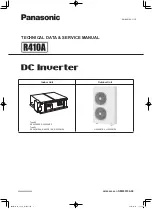
SiBE041025
Control Specification
Function and Control
25
Indoor Frequency Command (
∆
D signal)
The difference between the room temperature and the target temperature is taken as the “
∆
D
signal” and is used for frequency command.
∗
Th OFF = Thermostat OFF
Frequency Initial Setting
<Outline>
When starting the compressor, the frequency is initialized according to the
∆
D value and the Q
value of the indoor unit.
Q value: Indoor unit output determined from indoor unit volume, airflow rate and other factors.
PI Control (Determine Frequency Up / Down by
∆
D Signal)
1. P control
The
∆
D value is calculated in each sampling time (20 seconds), and the frequency is
adjusted according to its difference from the frequency previously calculated.
2. I control
If the operating frequency does not change for more than a certain fixed time, the frequency
is adjusted according to the
∆
D value.
When the
∆
D value is small, the frequency is lowered.
When the
∆
D value is large, the frequency is increased.
3. Frequency management when other controls are functioning
When frequency is drooping;
Frequency management is carried out only when the frequency droops.
For limiting lower limit
Frequency management is carried out only when the frequency rises.
4. Upper and lower limit of frequency by PI control
The frequency upper and lower limits are set according to the command on indoor unit.
When the indoor or outdoor unit quiet operation command comes from the indoor unit, the
upper limit frequency is lowered than the usual setting.
Temperature
difference (°C)
∆
D
signal
Temperature
difference (°C)
∆
D
signal
Temperature
difference (°C)
∆
D
signal
Temperature
difference (°C)
∆
D
signal
–2.0
∗
Th
OFF
0
4
2.0
8
4.0
C
–1.5
1
0.5
5
2.5
9
4.5
D
–1.0
2
1.0
6
3.0
A
5.0
E
–0.5
3
1.5
7
3.5
B
5.5
F
















































